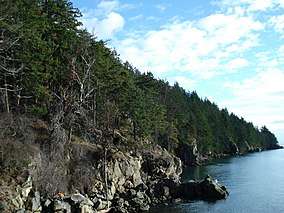Larrabee State Park
Larrabee State Park is a public recreation area located on Samish Bay on the western side of Chuckanut Mountain, six miles (9.7 km) south of the city of Bellingham, Washington. It was created in 1915 as Washington's first state park. The park covers 2,748 acres (1,112 ha) and features fishing, boating, and camping as well as mountain trails for hiking and biking. It is managed by the Washington State Parks and Recreation Commission.[2]
| Larrabee State Park | |
|---|---|
 The park's rocky saltwater coastline | |
 Location in the state of Washington | |
| Location | Whatcom, Washington, United States |
| Coordinates | 48°39′30″N 122°28′36″W[1] |
| Area | 2,748 acres (11.12 km2) |
| Elevation | 1,083 ft (330 m)[1] |
| Established | 1915 |
| Named for | Named for C.X. Larrabee |
| Operator | Washington State Parks and Recreation Commission |
| Website | Larrabee State Park |
History

In 1913, the governor of Washington, Ernest Lister, proposed establishing a park along Chuckanut Drive.[3] He mentioned this idea to Bellingham businessman Charles Larrabee, who agreed to deed waterfront property he owned in the area for the purpose. He died in 1914, but his wife Frances made sure the deal went through to completion. The governor officially accepted the park on October 23, 1915.[3] On November 22, 1915, Washington State Board of Park Commissioners formally accepted it as well, thus making it the first state park in Washington.[3] Initially called Chuckanut State Park, the park's name was changed to Larrabee in 1923.
The park began as a place mainly used for picnicking and to access the beach. After a series of relatively unsuccessful caretakers and trouble from the Great Depression, the park was experiencing low attendance by the early 1930s.[3] Things began to turn around in 1935 under the leadership of manager Dave Johnson, who spearheaded the effort to improve the park, rallying local organizations, schools, churches, and businesses to increase use of the park.[3] In 1936, the Works Progress Administration provided $30,000 in federal funding, leading to improvements such as playground equipment, a water system, and kitchen shelters.[3]
The Larrabee family donated another 1500 acres in 1937, with neighboring landowners making additional contributions. Further developments were made, and the park continued to attract visitors, reaching a quarter million annual visitors by 1965.[3]
Activities and amenities
.jpg)
The park features a short walk down to a pebble beach with views onto Samish Bay and the San Juan Islands. For longer excursions, there are 13 miles of biking trails and 15 miles of hiking trails, including trails leading 1,940 feet up Chuckanut Mountain. Picnicking, boating, saltwater fishing, sailboarding, and beachcombing along 8,100 feet of saltwater shoreline are among the other recreational options. Two mountain lakes, Fragrance Lake[4] and Lost Lake,[5] offer freshwater fishing for hikers.[2] The park also includes camping sites, an amphitheater, and large fields.[3]
References
- "Larrabee State Park". Geographic Names Information System. United States Geological Survey.
- "Larrabee State Park". Washington State Parks and Recreation Commission. Retrieved January 15, 2015.
- Dougherty, Phil (July 4, 2011). "Larrabee State Park (Whatcom County)". The Online Encyclopedia of Washington State History. HistoryLink. Retrieved February 12, 2016.
- "Fragrance Lake". Geographic Names Information System. United States Geological Survey.
- "Lost Lake". Geographic Names Information System. United States Geological Survey.
External links
| Wikimedia Commons has media related to Larrabee State Park. |
- Larrabee State Park Washington State Parks and Recreation Commission
- Larrabee State Park Map Washington State Parks and Recreation Commission